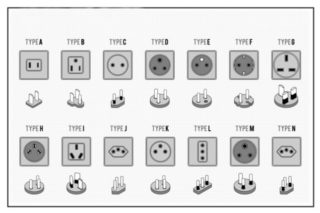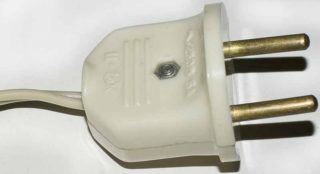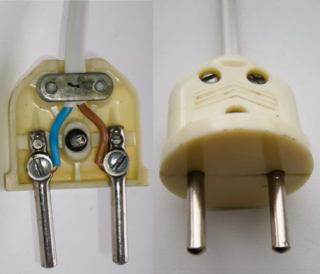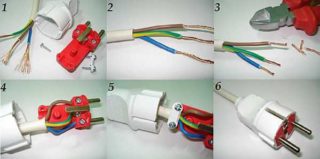The electric plug is designed to connect electrical appliances to an energy source. The mains plug is always attached to the end of the cable from the motor or motor of the device. There are different types of devices that differ in both characteristics and belonging to a specific type of electrical network.
Types of plugs

The Russian production of electrical appliances is somewhat different from the European one. However, the forks have similar features and appearance. Devices are collapsible and non-collapsible.
- C5 - is analogous to the European device CEE 7/16. The pins are insulated at half their length. They have a rounded shape, their thickness is 4 mm. The maximum load current for a plug device of this type is 6 A. At the same time, it can withstand up to 1300 W.
- C6 - similar to the European version of CEE 7/17. These devices, in turn, are two and three-pole (without and with grounding). The diameter of the rounded pins is 4.8 mm. The maximum load current is 10 A, with this parameter the plug can withstand power up to 2200 W.
- C1-b - equipped with round pins with a diameter of 4 mm. There is no grounding contact. The maximum load current is 6 A.
The manufacturer indicates the amount of current that the plug is capable of carrying. This designation does not mean that the device can be used under the condition of a given current strength.
Main settings

During the contact of the plug with the socket, high voltage is transmitted from the source to the consumer. This device has several parameters, without which it is impossible to select a product.
- Number of contacts. The most common version of the plug has two prongs. A US plug with a wire has three blades (grounding present).
- The form. The fixture can be round, square, oval, or angular. It all depends on what kind of design the manufacturer of electrical appliances comes up with.
- According to the design option, the forks are collapsible and cast. The first ones consist of a plastic body connected with special bolts. The non-dismountable device is made of dense rubber or hard plastic.
- Conforms to a specific standard: European or American.
In addition to the parameters, it is necessary to take into account the convenience and safety of the plug of the electrical appliance when choosing.
Almost all modern forks are repairable, provided they are collapsible.
Earthed plug

A grounding plug is used if a three-phase network is installed in the house. Otherwise, the third contact will not be used. This design is used exclusively in new buildings and creates additional safety when using an electrical appliance.
Equipped grounding allows the breakdown of current to be transmitted through the conductor system, preventing electrical fires and human injury.
World markings

The markings on the wire plug depend on the country in which the structure was manufactured. For each state standard, it is customary to assign individual types of plug devices.
- American copies are of types A and B. Such devices have flat pins.Option A is made without grounding, and the device with the designation B provides a place for its fastening.
- The euro plug is of type C. Equipped with two round contacts with no grounding.
- The D designation is assigned to fixtures made in England. It has three contacts: one thin and two thick.
- A flat F-type plug is grounded and has two blades for this.
- Two rounded pins are inserted into the French ones, and the third is arranged in sockets.
- Australian-style plugs are designated I, and in Israel they are assigned the letter H.
If the plugs do not fit into a standard household outlet and start to spark, it is advisable to use special adapters or extension cords.
Features of Russian electrical plugs

In Russia, there are collapsible and cast forks. They are usually already installed on the cords of electrical appliances, and therefore do not require special activation. C5 plugs are common and have round, thick pins. Suitable for powering equipment up to 1.3 kW.
There are single-phase plugs that come with powerful electrical appliances: saws, grinders, drills. Usually their design is non-separable, rubber is taken as the basis for production.
Designs of the C6 type are found on different versions of household appliances. Designed for power up to 2 kW, they have two or three contacts with a diameter of 4.8 mm. C1-b constructions are intended for devices with a power not exceeding 1.3 kW.
Which plug is better

Electrical plugs and sockets must match each other in the number of contacts and in the number of Amperes. It is believed that the collapsible design of the plug device is less reliable. In it, the contacts are often loosened, the connecting bolts loosen after prolonged use. As a result, it is unsafe to use the structure.
Cast products have a robust housing with reliable rubber or rubber insulation. Such a plug can last much longer without replacement. Also, some features differ in devices depending on the belonging class.
- Class A. Typically, structures of this type are used in Central America and Japan. One plug is thicker than the other. This is to maintain polarity.
- Class B. Designed for domestic use, has a grounding contact. Optimum current strength up to 15 Amperes.
- Class C. The European standard is similar to the options used in the USSR. These plugs are convenient and fit into the new type of plug, and only a flat plug will fit.
- Plugs of other standards. They are all different, but they may have the same connection method. Therefore, each of the options can be operated on any of the continents. Samples with the designation D, E, F and others can be used for power grids of the Russian Federation and Soviet sockets with a special adapter.
To create a single standard for electrical connection throughout the planet, all energy systems will have to be shut down for some time.
C1-b plug connection rules

For each individual device, depending on its class, there are individual connection nuances. Detachable plugs must be connected provided that the pins are in good contact with the conductors.
- Insulation is removed from two contacts at a distance of 2-2.5 m from the ends.
- Rings are formed and cleaned from the veins.
- Contacts are commutated with pins.
- Fits in seats.
- The parts of the fork body are connected to each other and twisted with bolts.
Be careful when stripping the insulation, it is better to use special scissors.
Connecting the wire to the plug C5 and C6

In devices of type C5 and C6, special compartments are already provided for installing contacts. Power cables, consisting of three conductors, must be folded in half and twisted before connecting to the blocks.Then the contacts are simply clamped in the seat with special screws.
If there is no grounding contact in the socket, the green conductor must not be used and connected to the base of the appliance or left open in the wall. For reliability, it is better to insulate it.
When installing the plug on a powerful electrical appliance, it is necessary to provide for possible overheating. It is desirable that the plug device has a power reserve, in no case should the indicator be less.
When replacing the plug on the wire, it is important to take into account all the markings and features of the sockets that will be used as a power source for the electrical appliance being repaired.








